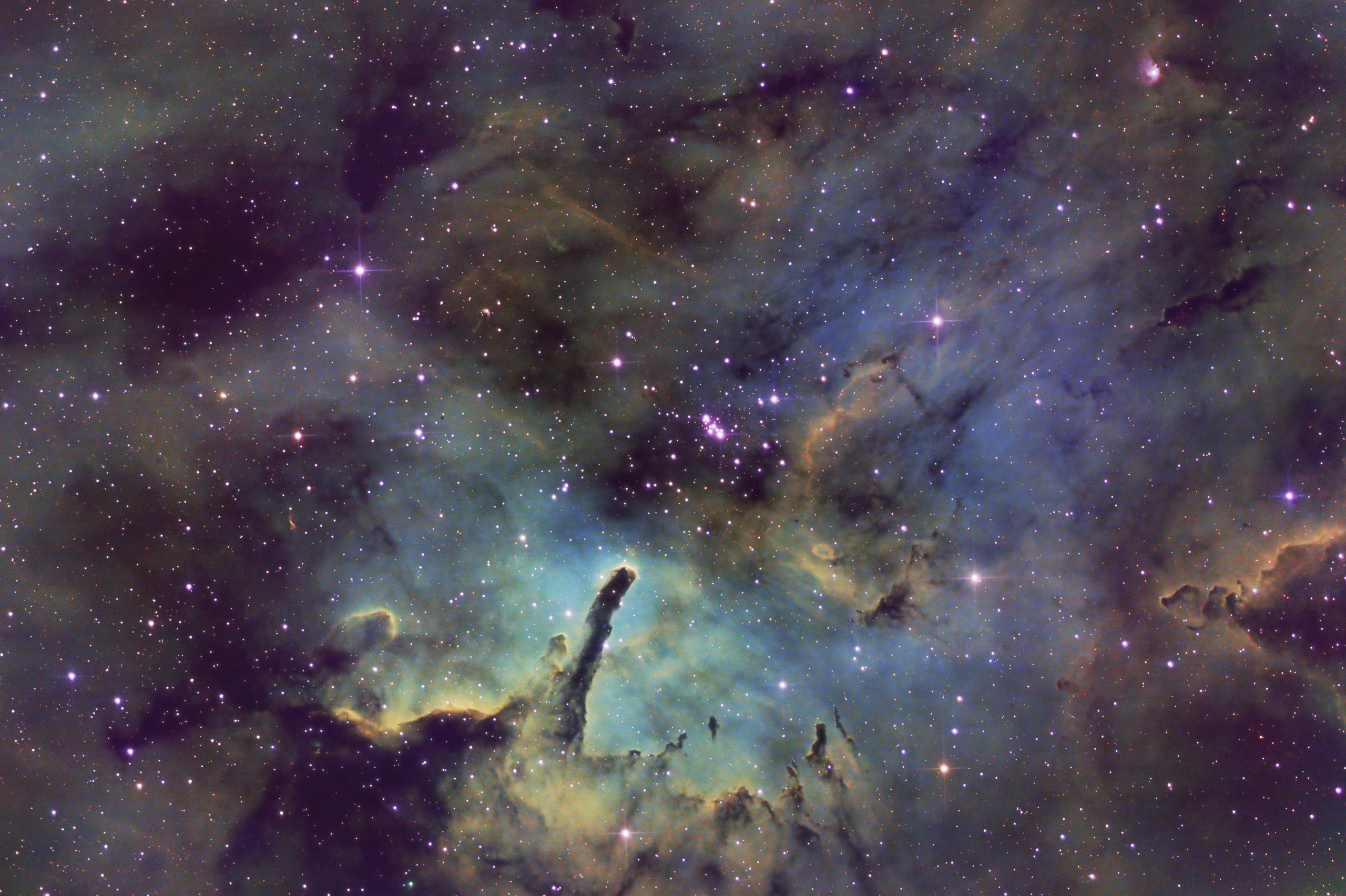The NGC 6823, in the center of this image, is a young galactic star cluser located at a distance of about 6,500 ly from Earth. It is classified as Trumpler IV 3p and is surrounded by the ionized hydrogen region Sharpless 2-86, which it excites with ultraviolet radiation coming from its young O and B-type stars. The cluster has a trapezium of bright stars in its center (Stone 1988).
Almost half a decade of studies of this area of the sky have identified a large population of young stellar objects (YSOs), such as pre-main sequence δ Scuti and UX Ori variables, T Tauri and Herbig Ae/Be stars (Lata et al. 2023) which are on their way to evolve to main sequence stars. The star cluster itself was formed about 3 myr ago and comprises the core of the Vulpecula OB1 stellar association – a giant molecular cloud located in the Local Spur – a layer of stars between the Local and Saggittarius Arms of our Galaxy (Billot et al. 2010). Many of the stars in the corona of the cluster appear to be only 0.5 Myr old, suggesting that the cluster had two distinct episodes of stellar formation (Stone 1988).
Dark molecular hydrogen pillars seen here are reminiscent of the famous Pillars of Creation of the Hubble’s Messier 16 nebula image. These pillars are often associated with the recent episodes of stellar formation, as they are formed due to the sculpting of material by radiation and energetic stellar winds (flow of gases) emanating from very young stars. The external pressure at the surface of these pillars is known to trigger further stellar formation. Many dark globules can be seen throughout the frame, some embedding YSOs.
The episodes of stellart formation could have been triggered by the cloud-cloud collision within the Vul OB1 molecular cloud (Kohno et al. 2022). Another trigger for a more recent stellar formation activity in the region could be the shockflows coming from the supernova associated with the remnant SNR G59.5+0.1 located outside of this frame, which is about 86,000 yr of age. YSOs that formed as little as 105→6 yr ago have been identified (Xu & Wang 2012, 2013) in the region, likely formed due to the collapse of the material in the molecular cloud. In particular, the expanding shell of SNR G59.5+0.1 is pressing against the Sh 2-86 H II region, with two arcs containing high density of YSOs identified around the supernova remnant.
At the top right of the frame, another nebula could be seen – NGC 6820, of which there are not many references available. Bronfman et al. (1996) identify it as an ultra-compact H II region. This site is also the source of methanol maser emission at 44 GHz, associated with the formation of high-mass stars (Litovchenko et al. 2011). Judging by the color matching nearby stars, the NGC 6820 nebula appears to have a predominant reflection component, as ionized hydrogen emission would be expected in green.
This narrowband image is captured in the SHO Hubble palette, with [S II], [O III] and H-alpha emission assigned to RGB channels respectively. It was obtained with the A1 telescope installed at the Alnitak Remote Observatory in Nerpio, Spain:
- 0.43 m PlaneWave CDK17 f/6.8 Corrected Dall-Kirkham Telescope
- Software Bisque Paramount ME German Equatorial Mount
- Moravian Instruments C3-61000 Pro, Back-Illuminated CMOS Camera
- Chroma 50 mm filters (5 nm narrowband)
- FLI CenterLine CL-1-14 12+2-position Dual Color Filter Wheel
- Optec Sagitta Off-Axis Guider with ASI174MM Guide Camera
Processing software used: ACP DC-3, MaximDL Pro, TheSky X, DeepSkyStacker, PixInsight, RC Astro BlurXTerminator and NoiseXTerminator, GIMP.
Full Scale Image
REFERENCES
Billot, N., Noriega-Crespo, A., Carey, S., et al. 2010, ApJ, 712, 797
Bronfman, L., Nyman, L.-A., May, J. 1996, A&AS, 115, 81
Lata, S., Chen, W. P., Pandey, J. C., et al. 2023, MNRAS, 520, 1092
Litovchenko, I. D., Alakoz, A. V., Val’Tts, I. E., Larionov, G. M. 2011, ARep, 55, 1086
Kohno, M., Nishimura, A., Fujita, S., et al. 2022, PASJ, 74, 24
Stone, R. C. 1988, AJ, 86, 1389
Xu, J.-L., Wang, J.-J. 2012, A&A, 543, 24
Xu, J.-L., Wang, J.-J. 2013, IAUS, 292, 63


